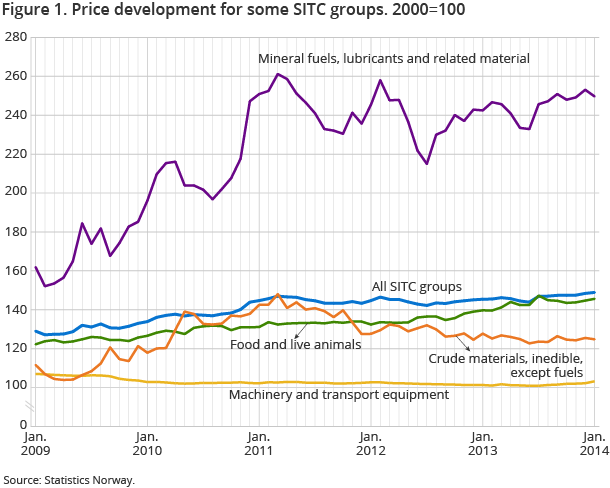Content
Published:
This is an archived release.
Weak rise in PIF
The price index of first-hand domestic sales (PIF) rose by 0.3 per cent from December 2013 to January 2014. The increase was mainly due to higher prices within machinery and transport equipment and chemicals. From January 2013 to January 2014, the PIF increased by 2.4 per cent.
| Per cent | Per cent | Index | Weights1 | |
|---|---|---|---|---|
| January 2014 / December 2013 | January 2014 / January 2013 | January 2014 | ||
| 1The weights are updated annually, and are valid for the entire year. | ||||
| Product groups | ||||
| Total index | 0.3 | 2.4 | 148.9 | 1 000.0 |
| Food | 0.6 | 4.2 | 145.6 | 180.1 |
| Beverages and tobacco | 0.6 | 6.4 | 155.1 | 15.0 |
| Crude materials, inedible, except fuels | -0.6 | -2.3 | 124.8 | 52.0 |
| Mineral fuels, lubricants and related materials | -1.3 | 3.0 | 249.7 | 240.4 |
| Chemicals and related products, n.e.s. | 2.5 | 4.3 | 149.3 | 68.4 |
| Manufactured goods classified by material | 0.5 | 1.1 | 130.9 | 126.6 |
| Machinery and transport equipment | 1.0 | 1.9 | 103.2 | 219.3 |
| Miscellaneous manufactured articles | 0.5 | 2.5 | 114.1 | 90.7 |

The price index of first-hand domestic sales (PIF) for all groups of goods was 148.9 in January (with 2000=100), compared with 148.4 the month before. The rise in the total index was due to a price increase within machinery and transport equipment, in which the import prices of power engines and equipment had a significant rise. Prices within chemicals rose due to higher prices in organic and inorganic chemicals, as well as raw materials of plastic. In addition, prices of food products had an increase from December to January, where higher prices of fish in the domestic market raised the food index.
For the total PIF, prices rose in both the domestic and import market. The price rise of domestic goods was mainly driven by higher prices within food products, while increasing import prices was due to higher prices in machinery and transport equipment in particular.
A decrease in the index of mineral fuels, lubricants and related materials lowered the total rise in the PIF from December to January. Petroleum and petroleum products played an important role in bringing the index down. Another important contributor to lowering the total PIF was crude materials, inedible, except fuel, where lower prices of metalliferous metals and metal scrap had the strongest influence.
Twelve-month change: prices up 2.4 per cent
The PIF rose by 2.4 per cent from January 2013 to January 2014. The main reasons for the increase in the total index were price rises in the commodity group mineral fuels, lubricants and related materials, as well as food products. Lower prices within crude materials, inedible, except fuels dampened the total rise in the PIF over the last twelve months.
Updated weights in the PIFOpen and readClose
The PIF is calculated as a weighted average of price changes. For the index to reflect the current structure of Norwegian production and imports, the weights used in the calculation are updated annually and introduced in the index from January. The weights did not change much from 2013 to 2014.
The weights are based on output and import values from national accounts. For details on industries’ weights, click the heading “tables” or go to StatBank and extract your own tables.
Additional information
Contact
-
Producer price index
E-mail: produsentpris@ssb.no
tel.: (+47) 21 09 40 00
-
Elisabeth Mælum
E-mail: elisabeth.maelum@ssb.no
tel.: (+47) 97 01 28 49
-
Monika Græsli Engebretsen
E-mail: monika.graesli.engebretsen@ssb.no
tel.: (+47) 40 90 23 71
-
Morten Madshus
E-mail: morten.madshus@ssb.no
tel.: (+47) 40 90 26 94
